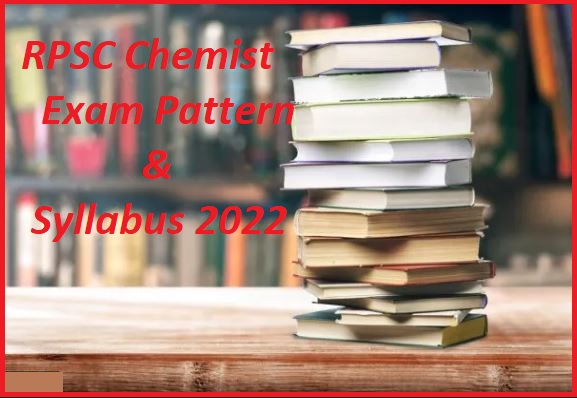RPSC Chemist Syllabus 2022 Check Exam pattern Here: Have you applied for the RPSC Chemist Post? Are you Looking for the RPSC Chemist Syllabus 2022? If it is yes, you’re in the Perfect Place to Check the RPSC Exam Pattern and Syllabus. The Rajasthan Public Service Commission has the Chemist Syllabus and Exam Pattern for the respective post those applicants in search of the RPSC Chemist Exam Syllabus and Exam Pattern 2022 then this article for you people just make use of this article to prepare well for the RPSC Chemist Syllabus and Exam Pattern 2022.

RPSC Chemist Syllabus 2022-Detail
| Check the Rajasthan PSC Chemist Exam Pattern and Syllabus 2022 | |
| Organization Name | Rajasthan Public Service Commission |
| Post Name | Chemist |
| Category | Syllabus |
| Job Location | Rajasthan |
| Website | rpsc.rajasthan.gov.in |
RPSC Chemist Exam Pattern 2022
| Subject | Question | Type Of Question | Mark | Exam Duration |
|
150 | Objective Type | 150 | 2 Hours 30 Min |
Rajasthan PSC Chemist Syllabus 2022
| Subject | Topics |
| General Chemistry | Ionization energy, electron affinity, electronegativity, ionic, covalent, coordinate, hydrogen bond, Vander Wall forces, Valence Bond Theory, hybridization, shapes of simple inorganic and organic molecules, VSEPR theory, introduction to Molecular Orbital Theory (MOT) of homo-nuclear and heteronuclear diatomic molecules. |
| Basic Organic Chemistry | Inductive effect, resonance, hyper-conjugation, isomerism, organic functional groups and their identification tests and nomenclature of organic compounds. Structure and important properties of alkanes, alkenes, alkynes, alcohols, aldehydes, ketones, carboxylic acids, amines, benzene, phenols, naphthalene, anthracene, furan, pyrole, pyridine and thiophene. |
| Reaction Mechanism | Types of reagents and reaction intermediates, free radicals, nucleophiles, electrophiles, carbonium ions, carbanions, nitrene, carbene, benzyne, substitution, addition, elimination and rearrangement reactions and aromaticity. |
| Name Reactions | Aldol Condensation, Baeyer – Villiger oxidation, Birch reduction, Diels – Alder reaction, Friedel-crafts reaction, Haloform reaction, Claisen-Schmidt reaction, Hofmann elimination, Mannich reaction, Pinacol-Pinacolone rearrangement, Reformatsky reaction, Reimer-Tiemann reaction and Wittig reaction. |
| Stereochemistry | Stereochemistry and conformational analysis of organic compounds, D-L notation, R-S notation, E-Z system of nomenclature, conformations of alkanes and cycloalkanes, optical activity and racemisation. |
| Analytical Techniques | Volumetric titrimetry (redox, complexometric and acid-base titrations), gravimetric analysis, Karl-Fischer method, potentiometric titrations, conductometric titrations and partition coefficient. Evaluation of analytical data- significant figures, precision, accuracy, errors, mean, median, mode and standard deviation. |
| Chromatography | Principle, instrumentation and applications of the following: a) Thin layer chromatography b) Paper chromatography c) Ion exchange chromatography d) Gas chromatography e) High performance liquid chromatography |
| Spectroscopy | Principle and applications of UV-Visible, IR, Mass and NMR spectroscopy in structure elucidation. |
| Biomolecules | Structure, classification and applications of molecules of biological importance – carbohydrates, amino-acids, proteins, enzymes, lipids, steroids, alkaloids, terpenoids and flavonoids. |
| Drugs and Their Applications | Drugs in the prevention and treatment of diseases under following category: (i) Cardiovascular drugs – Propranolol, Furosemide (ii) Antibiotics- Penicillin, Tetracycline (iii) Anti-malarial- Chloroquine, Primaquine (iv) Anti-pyretic and analgesic- Aspirin, Paracetamol (v) Anti-diabetic drugs- Insulin, Metformin (vi) Anti-tubercular – Isoniazid, Rifampicin (vii) Anticancer drugs- Doxorubicin, Paclitaxel (viii) Drugs acting on CNS: Barbiturates, Phenothiazines |
Rajasthan Public Service Commission Official Site

